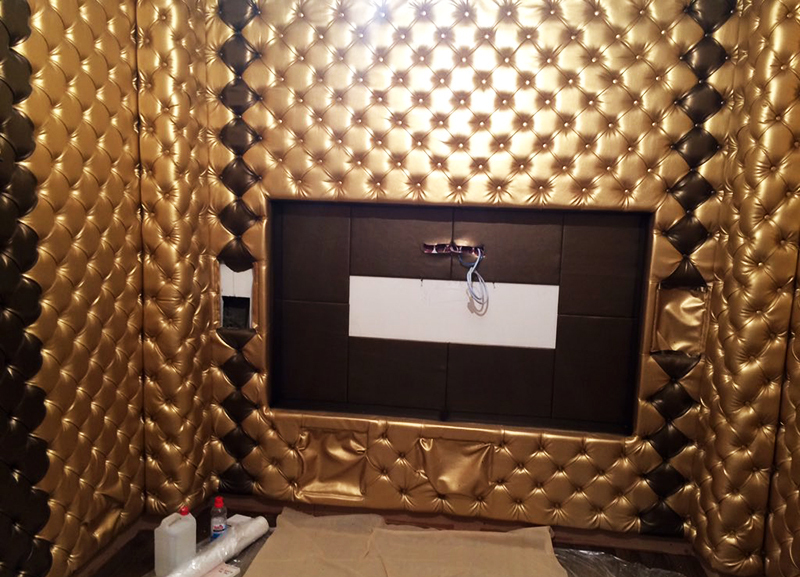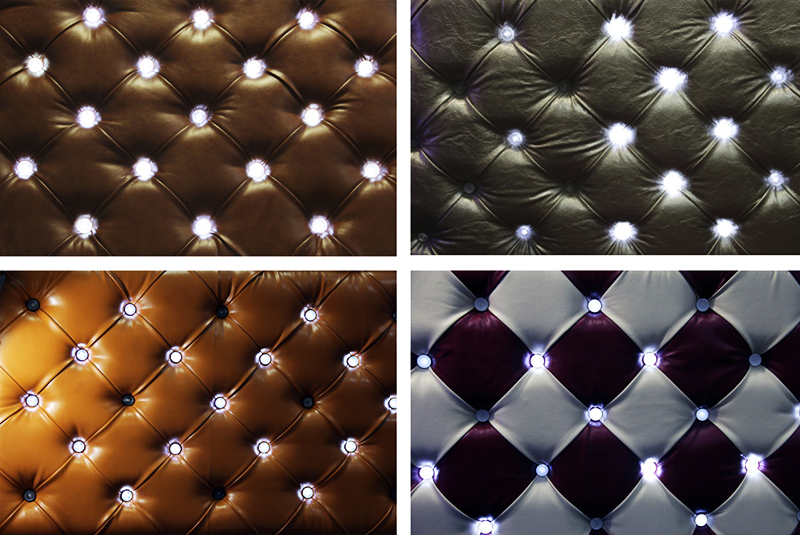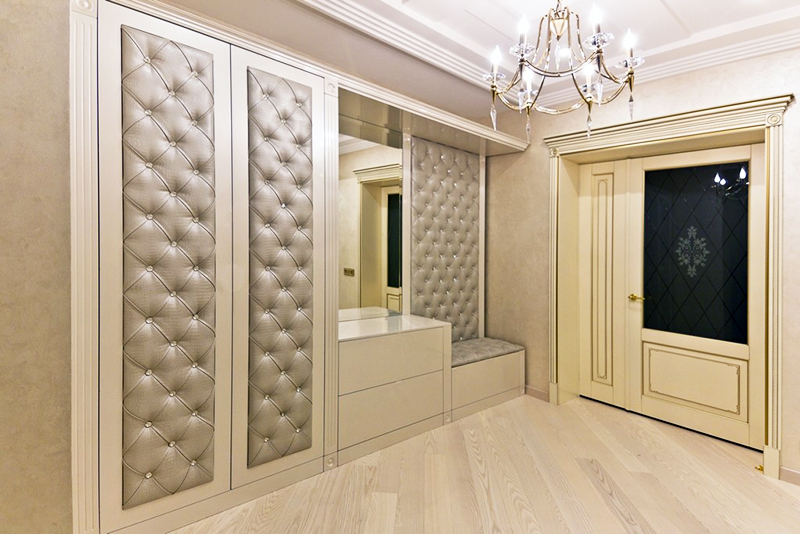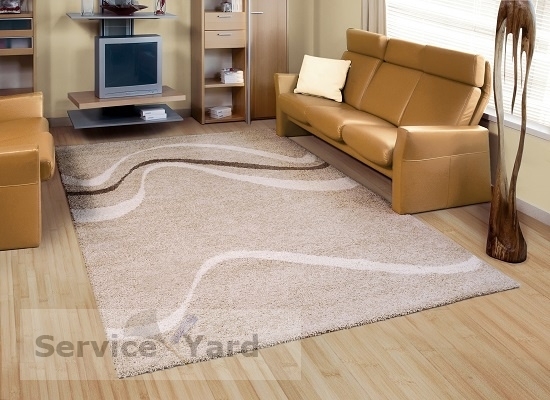There are many different materials and techniques for interior decoration. Some of them are ultra-modern, while others have a long history. Carriage screed is exactly the type of finish that has not been forgotten and is gaining popularity again. It is used to create exclusive interiors and furniture in the Baroque, Rococo, Renaissance, Art Deco and provence. Such a finish is not cheap, but HouseChief experts in this material will talk about it in more detail and prove that that a do-it-yourself carriage coupler is within the power of any person who has the desire and minimal experience with tools.
Read in the article
- 1 Carriage screed - what is it
- 2 Advantages and disadvantages
- 3 Carriage coupler in a modern interior
- 4 Choice of fabric and buttons
- 5 Making your own buttons
- 6 How to make a do-it-yourself carriage tie
- 6.1 Materials and tools
- 6.2 Drawing development
- 6.3 Foundation preparation
- 6.4 Lining attachment
- 6.5 markup
- 6.6 Tissue fixation
- 6.7 Capitonné upholstery using cut-out material fragments
- 6.8 decoration
- 7 Helpful Hints
- 8 Photo carriage coupler
- 9 A few words at the end
Carriage screed - what is it
Coach tie or capitonné is a type of finish that appeared in France in the 18th century and was used, as the name suggests, to decorate carriages. Since only the royal family, the aristocracy and very wealthy people could afford this vehicle, such design was considered an attribute of luxury and high status. Later, this technique began to be used for finishing upholstered furniture and interior items.

The capitonné technique involves fastening the upholstery to the base with filler using decorative buttons. The fixation elements are placed at the same distance from each other, forming a pattern of the correct geometric shape (rhombus, square, rectangle and less often a triangle).


Advantages and disadvantages
The use of the capitonné technique in interior and furniture decoration has a lot of undeniable advantages:
- creating a beautiful, elegant, exclusive appearance;
- the ability to fit the decorated element into the interior in any style due to the rich assortment of materials, textures and colors;
- decorating not only furniture, but also wall panels;
- durability and long-term operation without loss of attractive appearance;
- providing convenience and comfort;
- ease of care;
- high maintainability;
- additional heat and noise insulation when finishing walls.

However, the carriage screed also has disadvantages:
- reduction of usable space due to the volumetric finish;
- visual and physical increase in the volume of furniture and wall panels, which is undesirable for small rooms;
- ease of damage to inexpensive material;
- the difficulty of removing complex contaminants (oil, wax, etc.) from fabric upholstery;
- high price.

Carriage coupler in a modern interior
There are no carriages for a long time, but capitone is now often used in the decoration of expensive and exclusive cars. Also, the carriage screed is used to create original interiors. This technique makes it possible to produce original facing panels for walls, headboards and beautiful upholstered furniture.
The beauty of capitonné is achieved through a harmonious combination of expensive material, buttons and characteristic folds that form a geometric pattern. The pattern can have a different size and depth, which depends on the thickness of the filler and the tightening force of the fixing elements.
The carriage coupler looks beautiful and harmonious not only in the interiors of the classical style. Designers use it when decorating rooms in the style of art deco, boho, grunge, pop art or even minimalism. In modern interiors, capitonné is used minimally, in limited quantities - only then can it look organic.

Choice of fabric and buttons
The beauty, quality and durability of capitonné depends largely on the materials used. The fabric or skin in the process of tightening is subjected to heavy loads, and subsequently is under constant stress. Therefore, ordinary textiles are not suitable for carriage ties. When choosing a fabric, you need to pay attention to strength, density, wear resistance and quality. It is recommended to use a monochromatic material, since the pattern is partially hidden by folds and buttons, which spoils the appearance and showiness of the carriage finish.
The following materials are suitable for finishing in the capitonné technique:
- Flock. Artificial fabric with a fleecy texture. Available in a wide range of colors.
- Chenille. Natural, durable and wear-resistant material with a large selection of colors.
- Jacquard. Strong and durable fabric with a large pattern that holds wrinkles well. It is very difficult for beginners to work with her.
- Velours. Soft material, similar to flock, but more velvety. It is easy to work with and make deep folds.
- Leather. The most expensive and luxurious material, which is durable, wear-resistant, durable and beautiful appearance.
- Eco-leather. An excellent substitute for genuine leather, it fits well into folds, wear-resistant and keeps its shape perfectly.
Many mistakenly believe that the upholstery is tightened with buttons. In fact, the material is fixed with a strong thread, and buttons or carnations have only a decorative function. The facing of the clamps is made of the same material as the main upholstery. The latest "fashion" is the use of LEDs.


Making your own buttons
For carriage upholstery, all-metal buttons with an “eye” are used, since plastic counterparts do not withstand constant loads. Since it is difficult to choose ready-made upholstery buttons, most often they are made independently. It is better to purchase ordinary smooth buttons with a small margin, it will cost much less than buying special blanks designed for sheathing.
To make your own upholstery buttons for capito, follow the step-by-step instructions:
- Cut the upholstery into strips twice the diameter of the base.
- Cut the resulting strips into squares, from which, in turn, cut out circles.
- Along the edges of a fabric or leather blank, retreating a couple of millimeters, make medium-sized stitches in a circle with a needle and a strong thread folded in half.
- Insert a button in the center and pull the thread, as a result of which the material will wrap the metal blank. The smaller the stitch, the smoother the material will lie on the base.
This is a labor-intensive process, the result of which is worth the effort and time spent. But if finances allow, you can purchase universal buttons with a special rim for fixing upholstery.

How to make a do-it-yourself carriage tie
Before you make a carriage tie on the sofa or panels in the hallway, you need to prepare the drawing, materials and tools.

Materials and tools
To finish furniture and interiors using the capitonné technique, you will need the following materials:
- Plywood, OSB, Chipboard etc. to make the base. The material must be strong, relatively flexible and have a minimum thickness of 5 mm.
- Filler. Previously, horsehair was used, but modern designers offer foam rubber with a high density and a thickness of 50-70 mm as a filler.
- Sintepon, which is a layer between foam rubber and upholstery.
- Upholstery. The cut area should be 40% larger than the item being trimmed, since part of it will go to making buttons and creating folds.
- Metal buttons.

From the tools you will need:
- furniture stapler or stapler;
- drill or screwdriver;
- sharp knife;
- jigsaw;
- drill for wood;
- metal rulers and tape measure;
- pencils and markers;
- hook or needle 150–170 mm long;
- staples 8–10 mm;
- nozzle tsifenbor for drilling holes in the foam rubber and the base with a diameter of 10–12 mm;
- thick and durable nylon threads for tightening upholstery, capable of withstanding loads of 15–20 kg;
- specialized glue for foam rubber.
All tools must be of high quality, serviceable and well sharpened. It is also required to pre-make templates from thick cardboard or soft plastic.

Drawing development
The manufacturing technology of a carriage tie involves the development of a drawing or diagram. This is necessary not only to develop the shape of the product and create a pattern, but also to calculate the required amount of upholstery, fasteners and accessories.

Foundation preparation
On the prepared base, cut to the dimensions indicated in the drawing, markings are applied and holes with a diameter of 5–7 mm are drilled. Next, the base is smeared with special glue and a layer of foam rubber is laid on it, the size of which can be slightly larger than plywood or chipboard. On the filler, you also need to apply the selected pattern and drill the necessary holes. To facilitate the marking process and save time, you can use a pre-created template made of thick cardboard.

Lining attachment
After laying the filler, you need to cover it with a lining. A synthetic winterizer is often used as a lining material. It will help to make the upholstery softer, and the pattern - voluminous. Experts recommend using a synthetic winterizer in combination with foam rubber of small thickness. Fixing the lining to the base is carried out using a stapler and staples.

markup
After the main preparatory work, you need to mark up the upholstery. This is done from the wrong side, taking into account allowances. Rhombus or square increases in size by 40 mm. Upholstery marking can be done according to the same principle as on the basis and foam rubber or using a template. Next, you need to check the correctness of the markup and then make punctures with an awl or a needle at the corners of the square or rhombus to indicate the places where the buttons are fastened.
Tissue fixation
You should position the base in such a way that it is convenient to work with it, and carefully spread upholstery material on it. Now you need to cut a strong thread according to the number of buttons that will be used to fix the fabric or leather. Through the punctures on the material, stretch threads 40-60 cm long with buttons, row by row, forming the necessary folds. The ends of the thread are tied into a knot and fixed to the base with a stapler. Do the final fixation after making sure that all the folds are beautiful and even.
It is recommended to start the first row of ties from the middle of the canvas in order to avoid the formation of distortions. Next, you need to move in a circle, from the center to the edges. After fastening the buttons, the edges of the upholstery material are evenly stretched and fixed with staples from the wrong side of the plywood base. The last to align and bend the corners, which should not contain many folds. The excess is cut off with a knife.


Check out the detailed video tutorial on how to make a carriage tie at home.
Capitonné upholstery using cut-out material fragments
This method differs from the previous one in that the upholstery is not made from a single piece of fabric, but in cut fragments. Some note that this technology is much easier than working with a solid piece of material.
The initial stages (marking, preparing the base, laying the filler and synthetic winterizer) are similar to the first upholstery option. After that, square or diamond-shaped fragments are cut from the upholstery material according to the template with an allowance from a net size of 10-15 mm on each side. Each of the upholstery elements will be attached at the corners.
The two lower sides of the rhombus are folded over and fastened with staples to the plywood base through foam rubber. The top sides don't roll up. A decorative nail is driven into the lower corner of the rhombus. In a similar way - a neighboring fragment and so on along the row.
Fragments of the next row are also tucked up on the lower sides and overlapped on the previous row on the untucked edges. And so on until the upholstered part is completely filled (headboard, panel, sofa, etc.). The result should be a perfectly even upholstery with flawless folds.

You can learn more about how to make a carriage coupler using cut out fragments from this video.
decoration
Despite the fact that the carriage tie itself is a chic element of decor, additional decoration will not hurt it. The main decorative element of capitonné are beautiful smooth folds and buttons. However, you can additionally decorate the upholstery with the help of furniture nails with a wide curly hat, buttons with a flower-shaped head, with rhinestones or LEDs, baguettes, etc. Also, strips of upholstery material or silk twisted cord are used for decoration.



Helpful Hints
To make the carriage tie beautiful and of high quality, read the recommendations of experienced specialists:
- you definitely need a button layout, without which it is impossible to calculate the required amount of materials and make the perfect upholstery;
- if upholstery is done for the first time, it is advisable to practice on small parts;
- to fix the foam rubber, you need to use a special glue;
- the depth of the buttons should be the same;
- for upholstery, you should choose a dense, high-quality and plain fabric without a pattern;
- the thread or cord for fixing the buttons must be strong in order to withstand constant stress;
- cutting holes in the foam rubber is done only after the glue with which the filler is glued has dried.

After watching this video, even a beginner will be able to make a bed using the capitonné technique.
Photo carriage coupler
Check out a few photo examples of carriage ties in furniture and interiors.
1 out of 10

PHOTO: www.mixalmebel.com.ua

PHOTO: b2.3ddd.ru

PHOTO: static.wixstatic.com

PHOTO: dvervdom.ru

PHOTO: ivk-mebel.ru

PHOTO: restartm-kzn.ru

PHOTO: fabricssochi.net

PHOTO: chesterstyle.by

PHOTO: i.pinimg.com

PHOTO: mavery.ru
A few words at the end
Anyone can make the interior of their apartment or house more interesting and exclusive with the help of a carriage tie. We hope that the information we have provided will help you with this.
Basements in cities and private houses should not be built, they are often drowned. Regarding similar...
There was an idea to buy a country house with a carport. We found an interesting place near the…
We have been wanting to buy a painting on canvas for a long time and recently we were pleased with this by the company Va…
Didn't like the renovation. The kitchen is narrow, it was necessary to visually solve this particular pr…
unlike the palaces of our president's friends, this is just a miserable hut, albeit in style ...
Hello, my name is Andrey. I am buying information sites. There is…
and if the top layer of foam is not broken, then the lacquer surface greatly reduces the hygroscopic ...
strange reasoning regarding sealing. If the log is doused with sealant, foam ...
In the 80s he worked in one NPO, then hammer enamel was sintered. It turned out great,...
While in the summer I lived in the country a lot of different situations I saw and no one fines anyone. Uch…
You won't find a normal apartment for such a sum in Moscow. Even for a country house that …
Thank you. Briefly and clearly...
Karting. I want to help children! &nbs …
Now there is a very interesting and effective option for heating - plasterboard pas …



